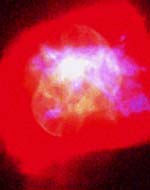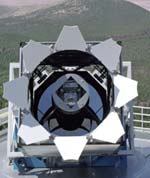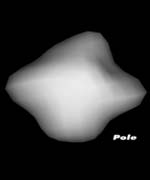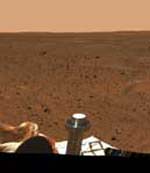
Image credit: Hubble
New research from the National Optical Astronomy Observatory may help to explain the formation and shape of many planetary nebulae. The culprit might just be binary star systems, where two stars orbit a common centre of gravity. Astronomers believe that planetary nebulae are caused when white dwarf stars slough off their outer layers, but they couldn’t explain how the nebulae could form jets of material or unusual lobes and prominences. A second star orbiting the dying white dwarf could whip up the outer layers into the strange shapes astronomers see.
Near the end of its lifetime, a star like the Sun ejects its outer layers into space, producing a hazy cloud of material called a planetary nebula. The complex shapes and dazzling colors of planetary nebulae make them some of the most popular objects in the night sky, for both amateur observing and scientific study.
New research suggests that many if not most of the stellar corpses at the centers of these wildly varied cosmic objects have companion stars, a surprising finding that will influence how astronomers explain their origins.
Astronomers used the Wisconsin-Indiana-Yale-NOAO 3.5-meter telescope at the National Science Foundation?s Kitt Peak National Observatory to take radial velocity measurements of 11 central stars of planetary nebulae (PNe), looking for the telltale, repeatable wobble that indicates the presence of a companion’s gravitational influence. This technique is also used to search for extrasolar planets around nearby stars. Ten of the 11 central stars of the PNe in the recent study showed clear evidence for radial velocity oscillations.
?If our current results are confirmed with further observations, we could be at the start of a revolution in the study of the origin of planetary nebulae,? says Howard Bond of the Space Telescope Science Institute in Baltimore, the principal investigator of the results presented today in Atlanta at the 203rd meeting of the American Astronomical Society. ?If these nebulae arise from binary stars, it implies a very different origin for these systems than what most astronomers had thought.?
It might be expected that nebulae ejected from spherical stars would be spherical, but many years of telescope observations show this not to be the case. In fact, most PNe are either elliptical or have pronounced lobes, often accompanied by jet-like structures.
There is general agreement that in order to eject gas with these observed morphologies, single stars would have to rotate rather rapidly or have reasonably strong magnetic fields, which themselves are the product of stellar rotation. However, the stars that most commonly eject PNe are large, bloated giants, indisposed to fast rotation.
?The most direct way to spin up these vast, fluffy stars is by the action of an orbiting companion. In extreme cases, as a red giant star gradually increases in size, it may actually swallow a companion star, which would then spiral down inside the giant and eventually eject its outer layers,? explains Orsola De Marco, an astronomer at the American Museum of Natural History (AMNH) in New York and the lead author of the publication reporting the first results of this project. ?Despite this, the mainstream astronomical view remains rooted in single star theories for the evolution of planetary nebulae, supported by the small percentage of planetary nebulae central stars that that were previously known to be binaries. However, our new research threatens to turn this viewpoint on its head.?
Astronomers currently believe that the majority of stars?those that begin with no more than eight times the mass of our Sun?end their lives by ejecting a planetary nebula and becoming a cosmic ember called a white dwarf. However, the new results from the WIYN telescope suggest that the story may be more complicated, in that an interaction with a companion star may be required to produce most planetary nebulae.
?We need more data to determine the exact periods of the binary central stars, since this is the only way to be sure of their binarity and eliminate other possible physical sources that could simulate the stellar wobble,? De Marco says. ?We are reasonably sure that these variations are due to binarity, but determination of their precise periods is the only way to be sure. We must also increase the size of our sample.?
Among the objects observed in this initial study are Abell 78, NGC 6891, NGC 6210, and IC 4593. The new radial velocity measurements were taken by the WIYN Hydra spectrographic instrument.
A previously released Hubble Space Telescope image of NGC 6210 is available at: http://hubblesite.org/newscenter/newsdesk/archive/releases/1998/36/image/a
Co-authors of this work are Dianne Harmer of the National Optical Astronomy Observatory (NOAO) in Tucson, AZ, and Andrew Fleming of Michigan Technological University in Houghton, MI, an NSF Research Experiences for Undergraduates (REU) student at AMNH during the summer of 2003.
These results (Abstract 127.03 in the AAS meeting program) will be discussed in an oral session that begins at 10:00 a.m. on Thursday, January 8, in Regency VI. This research has been accepted for publication in the February 1, 2004, issue of Astrophysical Journal Letters.
Images of other planetary nebulae taken by Kitt Peak telescopes are available in the NOAO Image Gallery at:
http://www.noao.edu/image_gallery/planetary_nebulae.html
and
http://www.noao.edu/outreach/aop/observers/pn.html.
The Wisconsin-Indiana-Yale-NOAO (WIYN) 3.5-meter telescope is located at Kitt Peak National Observatory, 55 miles southwest of Tucson, AZ. Kitt Peak National Observatory is part of the National Optical Astronomy Observatory, which is operated by the Association of Universities for Research in Astronomy (AURA), Inc., under a cooperative agreement with the National Science Foundation (NSF).
Original Source: NOAO News Release







